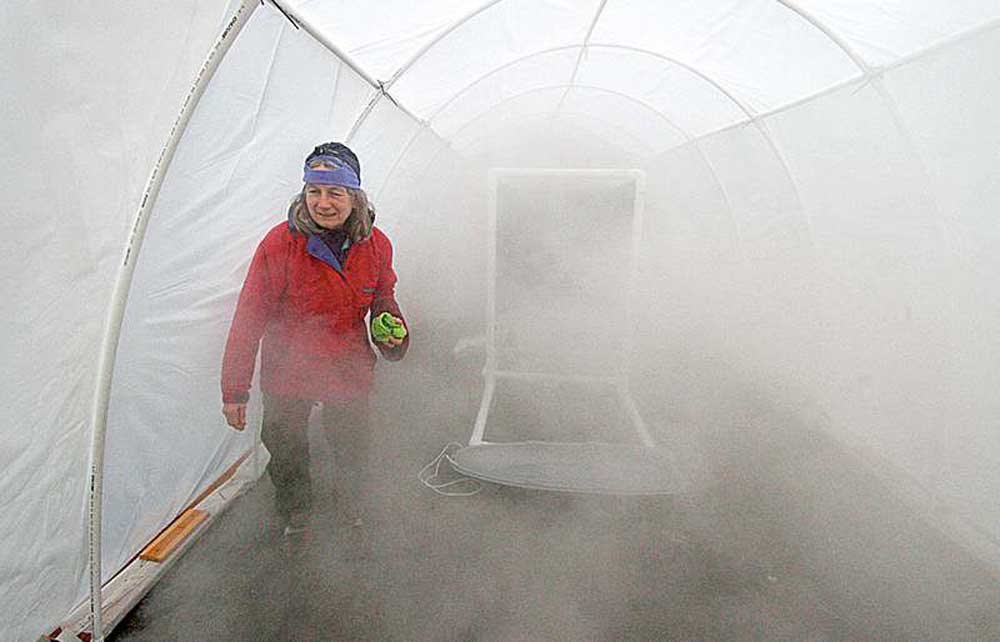Drawing water from the air (well, fog)
Published 5:00 am Tuesday, March 26, 2013

- University of Washington faculty member Susan Bolton is part of a team testing low-cost materials capable of “harvesting” water from fog.
It’s not a new idea, but researchers at the University of Washington are exploring new designs to improve yield and lower the cost, aiming to provide a boost to slum-dwellers in Peru.
SEATTLE — Fog has been billowing inside a small greenhouse on the University of Washington campus for the past month, but it doesn’t arrive on little cat feet. It comes hissing out of high-pressure nozzles.
The man-made mist is part of an effort to help slum-dwellers in Peru harvest moisture from the air. With a small grant from the Environmental Protection Agency, UW students and professors are building and testing fog catchers — and hoping to reel in a bigger grant to mount a full-scale operation in Lima.
“It’s like a cold sauna in here,” UW ecologist and civil engineer Susan Bolton said recently, ducking into the plastic “hoop house,” where industrial-grade misters spewed out a cloud of fine water droplets.
A noisy exhaust fan drew the cloud through a drape of black plastic netting. Droplets settled out on the mesh, coalesced and trickled into a plastic bucket. Forty-five minutes into the morning’s first test run, Bolton and graduate student Peter Cromwell emptied the bucket into graduated cylinders to measure the haul: 1,212 milliliters, or about a third of a gallon.
Wringing water from fog is not a new idea. Almost 2,000 years ago, the people of the Canary Islands gathered water that dripped from trees — nature’s own fog catchers. Several engineered fog-collection systems are in operation around the world today, including one in the highlands of Guatemala that provides a village of 200 people with nearly 2,000 gallons a day.
Standard fog catchers are large rectangles of plastic mesh suspended on frames. The UW project is exploring new materials and designs that may boost the yield and lower the cost, said Ben Spencer, assistant professor of landscape architecture. “The more water you can get, the better.”
Spencer is part of a group of UW faculty that has been working for several years in Lomas de Zapallal, a sprawling squatter community on the northern outskirts of Lima. Few homes have piped water, so people pay a premium to have it delivered by truck, Spencer said.
Lima is also one of the world’s most arid cities, with some neighborhoods receiving a scant half-inch of rain a year. But thick fog rolls in off the Pacific between June and December, making the area ideal for fog-catching.
For expert advice, the UW group turned to Robert Schemenauer, founder of FogQuest, a nonprofit based in Kamloops, B.C. An atmospheric physicist, Schemenauer pioneered most of the fog-collection systems in use today.
The technology will never be a substitute for large municipal water supplies, he said.
It works best in small, mountainous communities where frequent fog combines with a steady breeze needed to propel the mist through collectors.
Any new designs the UW team comes up with will have to be practical, above all, Schemenauer cautioned. “You need something that’s cheap and strong and will last for 10 years.”
Among the materials the UW group is testing are fibrous plastic mats used to stabilize slopes and turf. “We call them our hairy fog collectors,” Spencer said.
Early results suggest the greater surface area of the fuzzy mats may extract more water than the standard plastic mesh.
Students are also experimenting with collectors of different shapes, including one that resembles the mainsail of a sloop.






